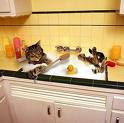 How To Clean Up Cat Urine
How To Clean Up Cat Urine By Staff Writer - howtodothings.com
As any cat owner will tell you, cat urine has a particularly intolerable - not to mention resilient - odor. On top of that, cat urine can stain carpet and hardwood floor alike. There are many reasons why cats might urinate in improper places - stinky litter boxes, stress, age and illness being among the common reasons. You'll be able to clean up stubborn cat urine using the following techniques.
a. For Hardwood floors.
Cat urine smell foul as it sinks into your hardwood floor. Worse still, it can stain and rot your floor if ignored.
Absorbent cloths. Blot the urine-soaked area using your dry cloth. Make sure you have some of these on hand in case of cat urine emergencies. A white cloth works fine (or many paper towels if you don't have a cloth), but cloth diapers absorb much better.
Household cleaners. You can then apply one of several household agents to the urine stain.
Many people swear by hydrogen peroxide to remove cat urine. If your peroxide is diluted to about 3%, you can spray it over the cat urine to remove both stain and odor. Let the peroxide sit for about five minutes before blotting. For an even stronger cleanser, add a couple squirts of hand soap and a sprinkle of baking soda to this spray. Shake it up, and watch it work.
Baking soda alone has been known to get rid of superficial odor-causing urine, but it won't help you remove urine stains in the wood.
NOTE: No matter what kind of cleaner you use or what surface you're cleaning (wood, carpet or furniture), you would be well advised to try the cleaning agent on a small, non-visible patch of the surface before applying it to the urine accident.
Store-bought urine cleaners. From your pet store, you can buy special anti-urine cleaners armed with necessary ingredients to break down the bacteria and enzymes of urine, fighting the stains and odors. Nature's Miracle, Urine-Off, Simple Solution and Stain Gobbler are just a few of the available brands. Either substitute these cleansers for the household ones above, or use the store-bought kind after the household variety.
b. For carpets.
Cat urine on carpet is more than a nuisance; it can penetrate through the fibers and into the padding, causing mold to go along with that awful smell.
Absorbent cloths. Blot the affected area as described in the hardwood section above. If you blot with pressure for about half a minute, and the cloth is dry, then you can continue to the next step.
Store-bought cleaning agents. Though you can try the aforementioned household cleaners first, your best bet is a heavy-duty store-bought cleaner designed specifically to target the bacteria and enzymes of cat urine accidents (you can find these at your pet store). After blotting with the cloth and applying pressure to remove as much of the liquid urine as possible, apply one of these urine cleaners, following the instructions on the package.
You may have to repeat the cleansing step a couple times.
c. Upholstery. It seems crazy, but cats can occasionally have accidents on your furniture as  well.
well.
Dab the spot dry.
One final reason for vigilance. Make a concerted effort to respond quickly and fully to cat urine - if you still smell urine after cleaning it up, then the cat can still smell it too. And that means the cat is more likely to urinate there in the future.
If you find yourself battling cat urine odor and stains, be comforted by the knowledge that you're not alone! Rapid response is best to prevent permanent stains. The most important strategy, of course, is prevention. Examine your cat's living environment, stress level and health. If your cat starts urinating outside of the litter box on a regular basis, schedule an appointment with a veterinarian to determine whether an underlying health concern exists. Clean thoroughly and, if you determine any causes of stress, try to eliminate them from your cat's life.
Additional Tips: Whether you have cats or dogs, finding pet friendly hotels will help with all your travel plans.




















